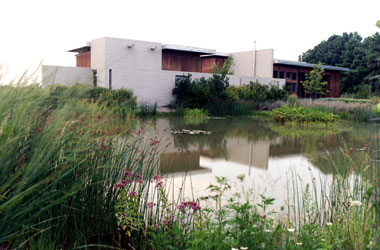|
James van Sweden's
Ultra-Modern Retreat James
van Sweden's ultra-modern vacation home is located in one of the oldest European
settlements in the New World and blends beautifully into the natural
landscape of this coastal region. Designed by his good friend Suman Sorg,
the 4,000-square-foot property consists of a main residence, guesthouse and
a courtyard
connected by a 140-foot long cinderblock "garden wall" which pays
homage to van Sweden's stature as a world-renowned landscape architect. The
wall, which
varies in height from twenty-four to twelve feet, actually forms some interior
walls of the residence and the effect is extraordinary. Sorg purposely gave the vacation house an industrial appearance so that it would contrast sharply with van Sweden's traditional Georgetown home. And indeed the two residences could not be more different. Consequently, "It took me two years to get used to it," van Sweden admits. Accustomed to living in a dark narrow townhouse, "I felt quite exposed in a house with 60-feet of glass and seventeen foot ceilings," "no draperies," and nothing but "mesh shades" as window dressings. The concrete and glass compound is perfectly situated on three acres on the Chesapeake Bay's Ferry Cove, which van Sweden purchased because "its flat landscape" reminds him of his native Holland. He also chose the Eastern Shore because after ten years of owning an Atlantic beachfront home in Rehoboth, he had tired of the ocean's "hostile" environment, preferring a place where the physical forces of nature are more subdued. On the scenic shores of the Chesapeake it takes the vision and skill of an artist and the expertise of an experienced horticulturist to improve upon nature's beauty. But, that is exactly what James van Sweden and his partner, Wolfgang Oehme, of Oehme, van Sweden & Associates, Inc., have done. By applying their principles of "The New American Garden," a landscape style that uses indigenous and existing plants to create a new "gardenscape," they have taken the Eastern Shore's pristine beauty and amplified it to create a meadow-like garden of sea grass and dune wheat. (Perhaps this is why Oprah Winfrey chose Van Sweden to design the grounds of her estate.) To add drama to the garden, van Sweden's planted a large grouping of Sylphium. Now nine-feet tall and in full bloom, their bright yellow daisy-like flowers mimic the warmth and well-being one naturally feels on a sunny summer day at the shore. Elsewhere, van Sweden added interest and shade with the artful placement of several native trees, including blackberry, magnolia, alder and persimmon. Obviously, the home's exterior both showcases and inspires van Sweden's talents as a landscape architect, but the home's interior is also conducive to his creative endeavors. His recently released "Architecture in the Garden" was largely composed in the comfortable confines of his country abode and he is currently working on his newest book tentatively titled, "The Arts Inspire The Garden," here as well. His interior décor is simple as well. He is, "a minimalist" who when it comes to furniture, prefers none. What furniture he does have is highly. He doesn't even have all the standard household appliances most people consider necessities. For example, he "doesn't have a refrigerator." Rather, he has four unobtrusive Sub Zero refrigerator and freezer drawers. His favorite room is the living room where he displays the work of modern artists and plays his grand piano for his own enjoyment. He has a strong preference for the screened-in front porch which he likens to his grandmother's front porch at her cottage on Lake Michigan, where he summered as a child. A white driftwood gazebo constructed by Ben Forgey, the son of the Washington Post's architectural critic, is another choice locale. Here at the water's edge van Sweden can often be found enjoying a sunset and a scotch. Flood-lighted at night, the ghostly gazebo rivals the house itself as an architectural focal point worthy of admiration and calls one's attention to the vast expanse of "gardenscape" between. In the summer van Sweden closes his office early each Friday, and, when not
on a lecture or book tour, spends his weekends immersed in his own personal
sea of beauty.
|







